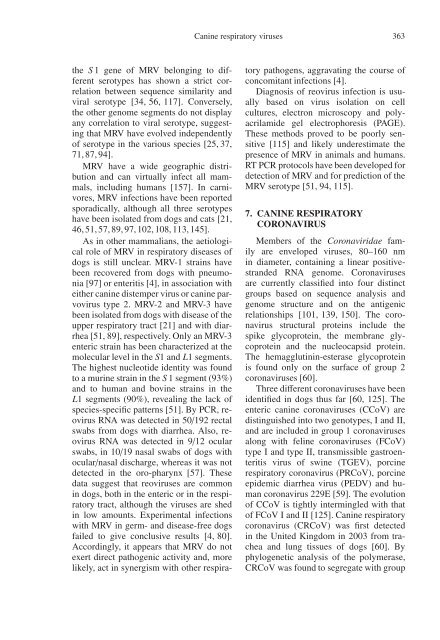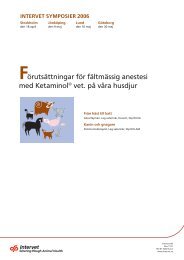KVÄLLSSYMPOSIUM 2008 Vaccinering av hund och katt
KVÄLLSSYMPOSIUM 2008 Vaccinering av hund och katt
KVÄLLSSYMPOSIUM 2008 Vaccinering av hund och katt
You also want an ePaper? Increase the reach of your titles
YUMPU automatically turns print PDFs into web optimized ePapers that Google loves.
the S 1 gene of MRV belonging to different<br />
serotypes has shown a strict correlation<br />
between sequence similarity and<br />
viral serotype [34, 56, 117]. Conversely,<br />
the other genome segments do not display<br />
any correlation to viral serotype, suggesting<br />
that MRV h<strong>av</strong>e evolved independently<br />
of serotype in the various species [25, 37,<br />
71, 87, 94].<br />
MRV h<strong>av</strong>e a wide geographic distribution<br />
and can virtually infect all mammals,<br />
including humans [157]. In carnivores,<br />
MRV infections h<strong>av</strong>e been reported<br />
sporadically, although all three serotypes<br />
h<strong>av</strong>e been isolated from dogs and cats [21,<br />
46, 51, 57, 89, 97, 102, 108, 113, 145].<br />
As in other mammalians, the aetiological<br />
role of MRV in respiratory diseases of<br />
dogs is still unclear. MRV-1 strains h<strong>av</strong>e<br />
been recovered from dogs with pneumonia<br />
[97] or enteritis [4], in association with<br />
either canine distemper virus or canine parvovirus<br />
type 2. MRV-2 and MRV-3 h<strong>av</strong>e<br />
been isolated from dogs with disease of the<br />
upper respiratory tract [21] and with diarrhea<br />
[51, 89], respectively. Only an MRV-3<br />
enteric strain has been characterized at the<br />
molecular level in the S1andL1segments.<br />
The highest nucleotide identity was found<br />
to a murine strain in the S 1 segment (93%)<br />
and to human and bovine strains in the<br />
L1 segments (90%), revealing the lack of<br />
species-specific patterns [51]. By PCR, reovirus<br />
RNA was detected in 50/192 rectal<br />
swabs from dogs with diarrhea. Also, reovirus<br />
RNA was detected in 9/12 ocular<br />
swabs, in 10/19 nasal swabs of dogs with<br />
ocular/nasal discharge, whereas it was not<br />
detected in the oro-pharynx [57]. These<br />
data suggest that reoviruses are common<br />
in dogs, both in the enteric or in the respiratory<br />
tract, although the viruses are shed<br />
in low amounts. Experimental infections<br />
with MRV in germ- and disease-free dogs<br />
failed to give conclusive results [4, 80].<br />
Accordingly, it appears that MRV do not<br />
exert direct pathogenic activity and, more<br />
likely, act in synergism with other respira-<br />
Canine respiratory viruses 363<br />
tory pathogens, aggr<strong>av</strong>ating the course of<br />
concomitant infections [4].<br />
Diagnosis of reovirus infection is usually<br />
based on virus isolation on cell<br />
cultures, electron microscopy and polyacrilamide<br />
gel electrophoresis (PAGE).<br />
These methods proved to be poorly sensitive<br />
[115] and likely underestimate the<br />
presence of MRV in animals and humans.<br />
RT PCR protocols h<strong>av</strong>e been developed for<br />
detection of MRV and for prediction of the<br />
MRV serotype [51, 94, 115].<br />
7. CANINE RESPIRATORY<br />
CORONAVIRUS<br />
Members of the Coron<strong>av</strong>iridae family<br />
are enveloped viruses, 80–160 nm<br />
in diameter, containing a linear positivestranded<br />
RNA genome. Coron<strong>av</strong>iruses<br />
are currently classified into four distinct<br />
groups based on sequence analysis and<br />
genome structure and on the antigenic<br />
relationships [101, 139, 150]. The coron<strong>av</strong>irus<br />
structural proteins include the<br />
spike glycoprotein, the membrane glycoprotein<br />
and the nucleocapsid protein.<br />
The hemagglutinin-esterase glycoprotein<br />
is found only on the surface of group 2<br />
coron<strong>av</strong>iruses [60].<br />
Three different coron<strong>av</strong>iruses h<strong>av</strong>e been<br />
identified in dogs thus far [60, 125]. The<br />
enteric canine coron<strong>av</strong>iruses (CCoV) are<br />
distinguished into two genotypes, I and II,<br />
and are included in group 1 coron<strong>av</strong>iruses<br />
along with feline coron<strong>av</strong>iruses (FCoV)<br />
type I and type II, transmissible gastroenteritis<br />
virus of swine (TGEV), porcine<br />
respiratory coron<strong>av</strong>irus (PRCoV), porcine<br />
epidemic diarrhea virus (PEDV) and human<br />
coron<strong>av</strong>irus 229E [59]. The evolution<br />
of CCoV is tightly intermingled with that<br />
of FCoV I and II [125]. Canine respiratory<br />
coron<strong>av</strong>irus (CRCoV) was first detected<br />
in the United Kingdom in 2003 from trachea<br />
and lung tissues of dogs [60]. By<br />
phylogenetic analysis of the polymerase,<br />
CRCoV was found to segregate with group





